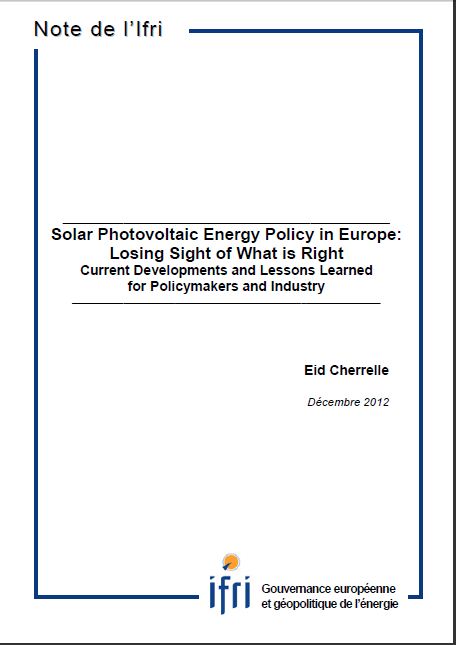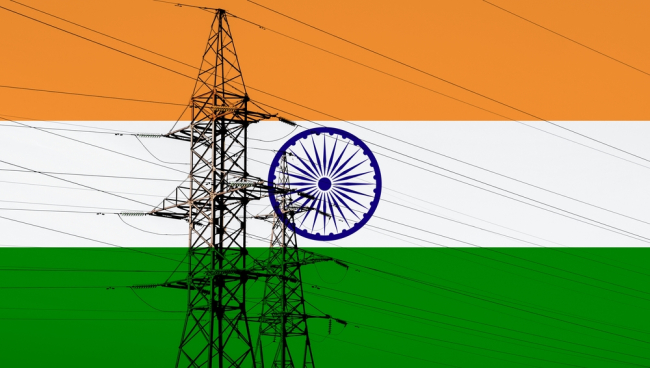Solar Photovoltaic Energy Policy in Europe: Losing Sight of What is Right: Current Developments and Lessons Learned for Policymakers and Industry

Europe has set ambitious but drastic targets in order to fight climate change. The 20-20-20 objectives demonstrate this. By 2020, emissions are to be reduced by 20%, the share of renewable energy sources (RES) in energy consumption is targeted to rise to 20%, and energy efficiency is planned to increase by 20% in comparison to the 1990 levels in Europe.
In order for Europe to reach these objectives, national targets for each Member State have been set. While not yet officially binding, the 2050 Roadmap of the Commission is focused on achieving even stronger reductions, namely a reduction of 80% in emissions compared to 1990 levels. The 2020 objectives account for less than half of these 2050 objectives.
Consequently, Member States are currently under pressure to formulate efforts seriously to comply with their national and European targets as part of the objective of sustainability. European countries have increased capacity of renewables: hydroelectric power, wind power, biomass and solar energy are increasingly produced. As part of the planned renewable electricity capacities for 2020, solar photovoltaic panels (PVs) are the third largest installed RES source, after hydroelectric capacity and wind capacity.
PV is an interesting renewable source for several reasons. First, PV uses an energy source which is available daily: the sun. Secondly, PV has shown positive cost and efficiency improvements over time, which makes it increasingly interesting from a business perspective. It is assumed that PV will provide electricity at competitive prices soon in some countries. Thirdly, PV is one of the few domestically usable applications for electricity generation. This might shift the position of consumers to being co-producers or so-called prosumers. These are a few of the reasons that explain the interest in analyzing efforts linked to PV.
From an industrial point of view, PV panels are produced in-and outside Europe. Looking from a European perspective, it is interesting to examine China and the United States in regard to PV manufacturing and installation capacity. China may be characterized by its high and early PV production, exporting almost 90% of its output. What will this and other developments mean for European PV industry and job creation?
At present, the deployment of PV is under much discussion in many countries, within and outside of Europe. Changes in Feed-in-Tariffs (FIT) are following each other closely and motivations behind deployment are presently frequently discussed in the political sphere. Still, there are important points to consider. What are the costs of PV? How are the costs expected to decrease and how effective are current policies concerning PV penetration? Are these policies also effective in eventually reaching the CO2 reduction targets? PV technologies are still developing and it is important to not be moved by assumptions on efficiencies or effectiveness of the technology.
The aim of this report is to provide recommendations for the debate concerning PV deployment in Europe and to provide suggestions for both policymakers and industry in- and outside of Europe. This is done by analyzing the main developments related to PV worldwide. The report will furthermore present technical developments of PV and will present a comparison in the international context with US and Asia.
In Section 2, the position of PV policy is given within the EU renewable projections for 2020. Before continuing with the support policies for PV in Section 4, the main developments in PV technologies with definitions are provided in Section 3. Afterwards, case studies of the five major European countries with the largest European installed capacities in PV are presented with their efforts and policies associated to PV in Section 5. In Section 6, an evaluation of the European Policy is presented, after which a brief review of the US and China and their PV industries is given with their policy incentives to increase PV installation in Section 7. Finally, this report ends with a conclusion in Section 5, providing the recommendations for policymakers and industries in a global context.
This study only focuses on Solar Photovoltaics, and not on Thermal Solar energy (which uses the heat to generate electricity). Additionally, the reader should be warned that FIT and PV connected regulation is constantly changing. Due to this, data given might not all be totally up to date when this report is published.

Also available in:
Regions and themes
ISBN / ISSN
Share
Download the full analysis
This page contains only a summary of our work. If you would like to have access to all the information from our research on the subject, you can download the full version in PDF format.
Solar Photovoltaic Energy Policy in Europe: Losing Sight of What is Right: Current Developments and Lessons Learned for Policymakers and Industry
Related centers and programs
Discover our other research centers and programsFind out more
Discover all our analysesIndia’s Broken Power Economics : Addressing DISCOM Challenges
India’s electricity demand is rising at an impressive annual rate of 9%. From 2014 to 2023, the country’s gross domestic product (GDP) surged from 1.95 trillion dollars ($) to $3.2 trillion (constant 2015 US$), and the nation is poised to maintain this upward trajectory, with projected growth rates exceeding 7% in 2024 and 2025. Correspondingly, peak power demand has soared from 136 gigawatts (GW) in 2014 to 243 GW in 2024, positioning India as the world’s third-largest energy consumer. In the past decade, the country has increased its power generation capacity by a remarkable 190 GW, pushing its total installed capacity beyond 400 GW.
The Troubled Reorganization of Critical Raw Materials Value Chains: An Assessment of European De-risking Policies
With the demand for critical raw materials set to, at a minimum, double by 2030 in the context of the current energy transition policies, the concentration of critical raw materials (CRM) supplies and, even more, of refining capacities in a handful of countries has become one of the paramount issues in international, bilateral and national discussions. China’s dominant position and successive export controls on critical raw materials (lately, germanium, gallium, rare earths processing technology, graphite, antimony) point to a trend of weaponizing critical dependencies.
The Aluminum Value Chain: A Key Component of Europe’s Strategic Autonomy and Carbon Neutrality
The United States of America (US), Canada and the European Union (EU) all now consider aluminum as strategic. This metal is indeed increasingly used, especially for the energy transition, be it for electric vehicles (EVs), electricity grids, wind turbines or solar panels.
The EU Green Deal External Impacts: Views from China, India, South Africa, Türkiye and the United States
Ahead of June 2024 European elections and against the backdrop of growing geopolitical and geoeconomic frictions, if not tensions, between the EU and some of its largest trade partners, not least based on the external impacts of the European Green Deal (EGD), Ifri chose to collect views and analyses from leading experts from China, India, South Africa, Türkiye and the United States of America (US) on how they assess bilateral relations in the field of energy and climate, and what issues and opportunities they envisage going forward.












